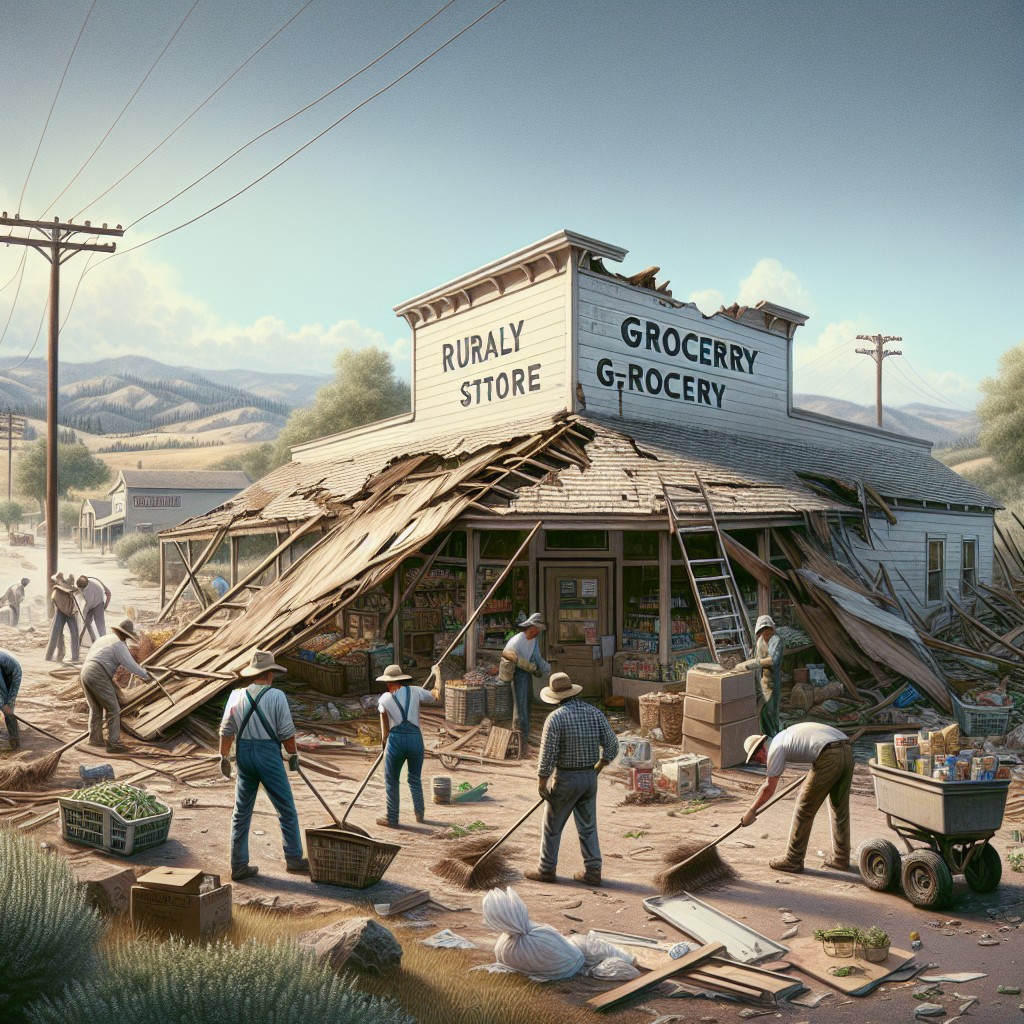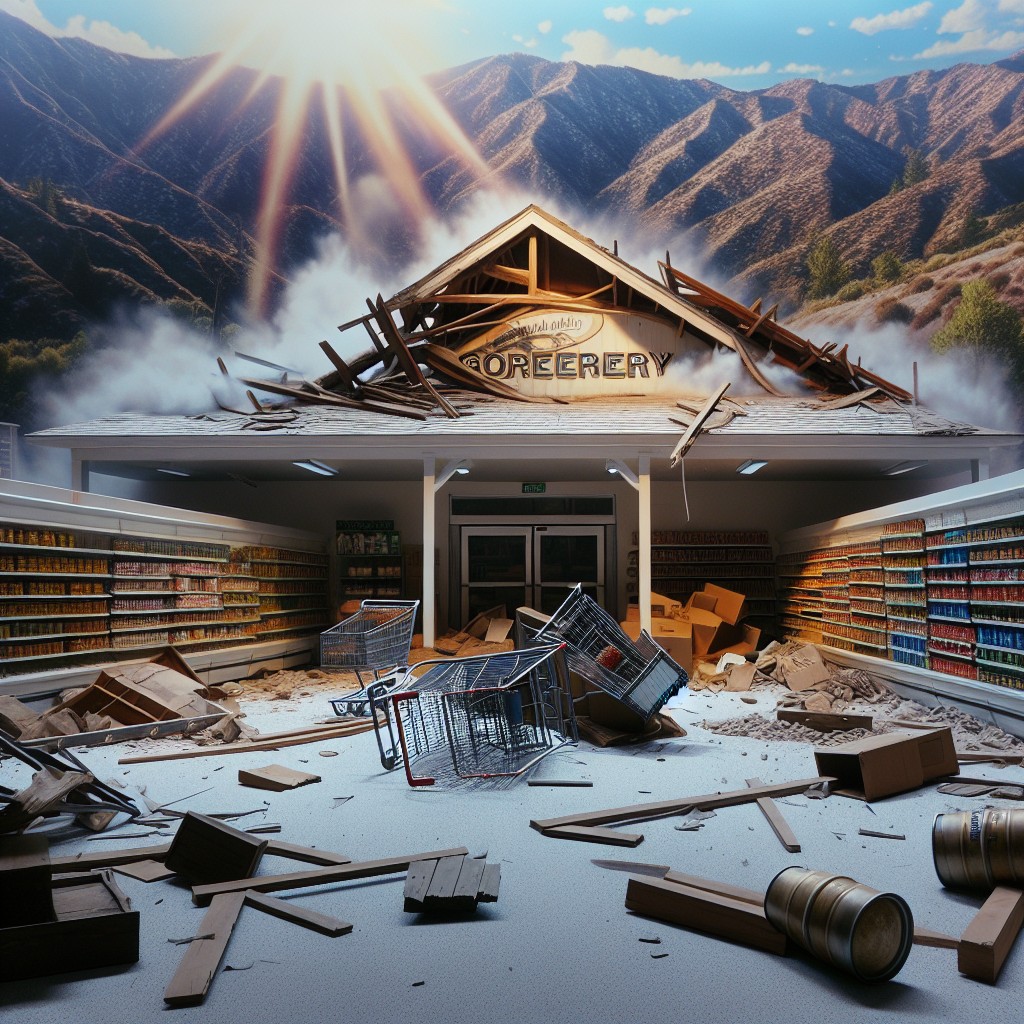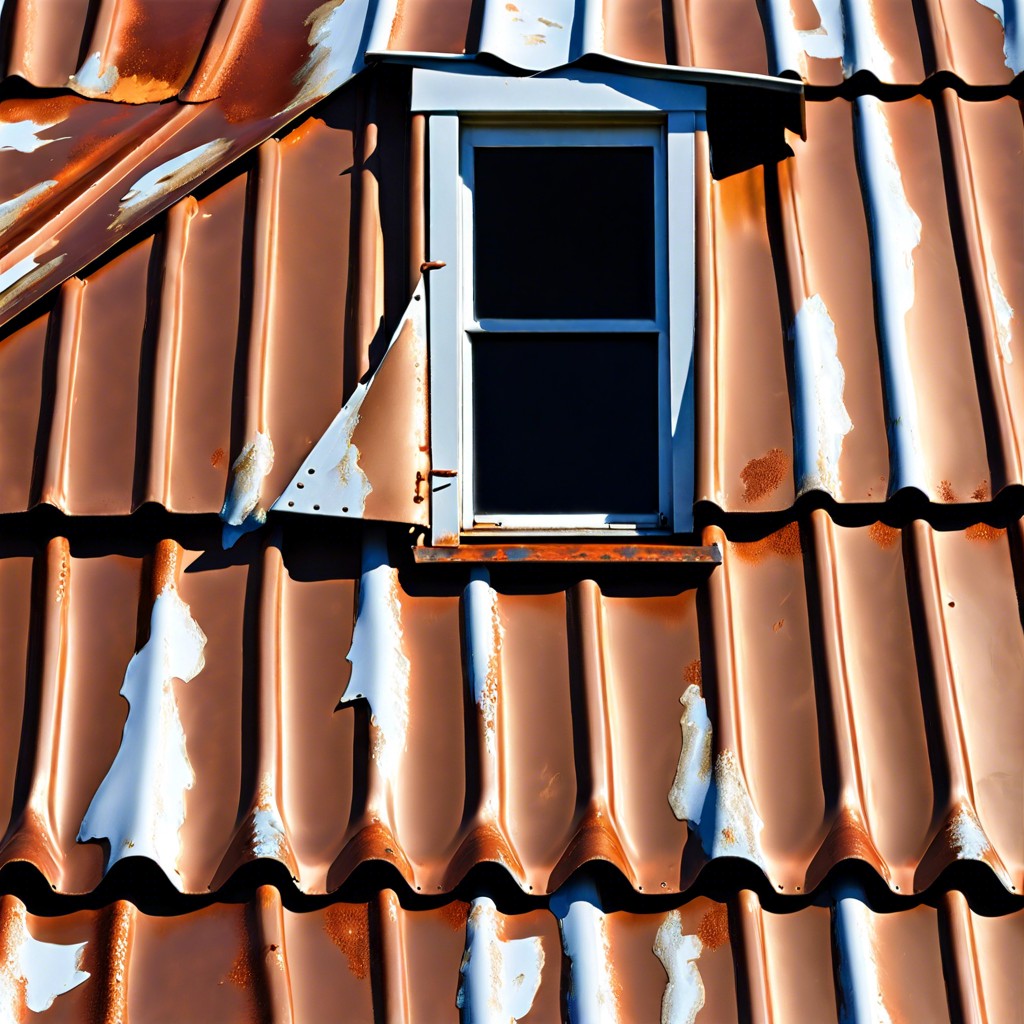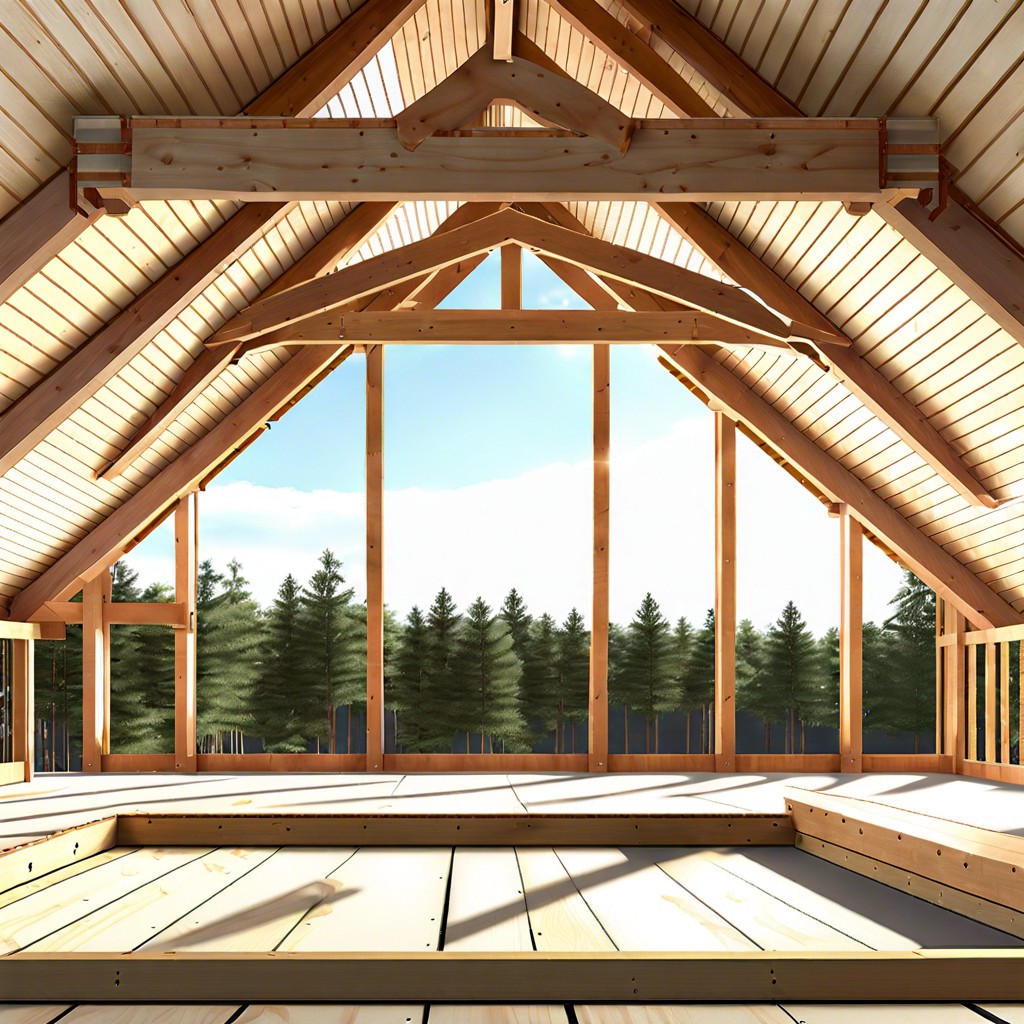Last updated on
Explore this article because it provides a detailed account of the unusual occurrence of a grocery store’s roof collapse in Crestline, CA, shedding light on the possible causes and future preventative measures.
In the serene mountain town of Crestline, California, the unexpected collapse of Goodwin & Sons Market’s roof stands as a stark reminder of nature’s formidable force when heavy snowfall exceeds structural limits.
This harrowing event not only disrupted the tranquil life of the community but also raised urgent questions about building resilience and safety measures in snow-prone areas.
In the following account, you will find a detailed examination of the factors that led to the structural failure, the immediate aftermath of the collapse, the personal toll on those injured, and the broader impact on local commerce.
Dive into the comprehensive analysis to understand the full implications of this local calamity and the lessons that can be gleaned for future preventative strategies.
Key takeaways:
- The grocery store roof collapse in Crestline, CA was caused by heavy snow accumulation.
- The incident occurred at Goodwin & Sons Market in Crestline, CA.
- The collapse resulted in significant structural damage to the store.
- Five individuals sustained injuries, but there were no fatalities.
- The community and local businesses have been greatly impacted by the incident.
Incident Overview: Crestline CA Grocery Store Roof Collapse

On a seemingly ordinary day, the roof of a frequented grocery store in Crestline, California gave way, sending shockwaves through the local community. This sudden structural failure occurred without warning, altering the routine bustle of shoppers and employees in an instant.
Emergency responders were swiftly dispatched to the scene, prioritizing the assessment of human safety and securing the site. They worked diligently to evaluate the extent of the damage and to ensure the well-being of those affected.
Amid the chaos, the question on everyone’s mind was clear: What could have caused such a catastrophic event? Preliminary speculations pointed to the weight of recent heavy snowfall, a factor common to many buildings in the wintry mountain region.
As the dust settled, the incident brought to light the importance of regular building assessments, especially in areas prone to severe weather. It also underscored the need for emergency preparedness within the community and among local businesses.
While the collapse was a sudden and alarming event, the community’s response exemplified the resilience and collaborative spirit inherent in the town of Crestline.
Date and Time of the Collapse

The incident occurred in the early hours of a Thursday morning, at approximately 9:15 AM. Employees and a handful of customers were present in the building when the structure gave way.
The timing of the collapse played a crucial role in the scale of the emergency response required and the number of individuals impacted. While no immediate cause was apparent, the event’s timing coincides with a period of heavy snowfall that had been affecting the region, a factor which would be investigated for its potential contribution to the structural failure.
Location Details: Address and Store Name
Nestled in the heart of the San Bernardino Mountains, the incident occurred at Goodwin & Sons Market, a well-established staple for residents and visitors alike.
Located at 24089 Lake Gregory Drive, Crestline, California, this locally owned grocery has been serving the community for years, offering fresh produce, meats, and household necessities.
Accessible via the scenic Rim of the World Highway, the market is known for its rustic charm and convenient placement for mountain residents in the vicinity of Lake Gregory Regional Park.
The roof collapse has temporarily halted the store’s operations, deeply impacting the daily routines of those who depend on its services for their shopping needs.
Structural Damage: Extent and Description
The roof’s collapse compromised the grocery store’s structural integrity significantly. Key support beams gave way, leading to an inward crumple of the roofing material.
Sections of the roof directly impacted by the snow’s weight displayed pronounced caving. Inside, the ceiling fixtures and HVAC systems were heavily damaged, creating a hazardous environment.
Visible cracks and stress marks along the perimeter walls suggest potential foundation issues. While the storefront and signage remained largely intact, the entryway was obstructed by debris.
Store shelving and inventory underneath the collapse zone were crushed or scattered, emphasizing the force of impact.
Assessing the full scope of the damage will require further analysis by structural engineers.
Immediate Response: Emergency Services Involvement
Following the roof collapse, first responders were dispatched to the scene promptly. The quick arrival of fire, police, and paramedic teams ensured immediate assistance to those affected.
The area was cordoned off to maintain public safety and to facilitate the rescue operations. Emergency personnel conducted a thorough search to locate and assist any trapped individuals.
Meanwhile, medical staff triaged victims on site, providing essential care and transporting those with serious injuries to nearby medical facilities. Authorities also worked closely with utility companies to secure the site, including shutting off gas lines and addressing potential electrical hazards.
The presence of these teams played a crucial role in managing the situation effectively and minimizing harm to the individuals involved and the surrounding community.
Injuries and Fatalities: Number of Victims and Their Conditions
Amid the frightening collapse, emergency services swiftly confirmed that a total of five individuals sustained injuries. These victims were promptly attended to by first responders, with the severity of injuries ranging from minor cuts and bruises to one case of serious injury that required hospitalization.
Thankfully, no fatalities were reported. The store was moderately occupied at the time, which potentially minimized the number of injuries. The safety and well-being of store employees and patrons were prioritized as local authorities quickly secured the scene to prevent further harm.
Local paramedics and fire departments remained on the scene to ensure that anyone needing medical attention received it immediately. Hospital and trauma centers in the vicinity were put on alert to provide necessary medical care to the injured.
The local community has shown immense solidarity, with nearby businesses and residents offering assistance and support to those affected. The current condition of the hospitalized individual is stable, and they are receiving appropriate care. Further updates on the recovery of all individuals are anticipated as information becomes available.
Store Occupancy: Number of People Present During the Incident
At the time of the roof collapse, the store was moderately occupied with both shoppers and staff. While detailed figures have not been publicly released, early reports suggest that there were approximately 30 individuals inside the premises. This occupancy level is typical for the store at that hour, emphasizing the potential scale of the incident.
It’s important to highlight:
- The majority of those present were located in the main shopping aisles, away from the heavier structural impact zone by the rear of the store.
- Quick action taken by staff members helped to facilitate an orderly evacuation, minimizing the risk of injury.
- The store’s layout, with clearly marked exits, played a critical role in the efficiency of the emergency response.
- Occupancy numbers are being used to cross-reference with security footage to ensure all individuals have been accounted for.
Eyewitness Accounts
Shoppers and employees inside the store provided firsthand insights into the moment the roof gave way. Reports detail a loud crashing sound followed by confusion and dust filling the air.
Patrons initially mistook the noise for nearby construction before realizing the calamity unfolding above them. Quick action from store staff helped customers evacuate the premises, averting potential injuries.
Exteriorside surveillance footage revealed the roof’s gradual succumbing to the snow’s weight, offering a visual timeline consistent with bystander descriptions.
This collective narrative aids investigators in piecing together the event’s chronology and causal factors.
Potential Causes of the Collapse: Weather Conditions, Structural Integrity
Severe weather, particularly heavy snowfall, puts additional weight on rooftops that can exceed their designed load capacity, leading to a heightened risk of collapse. In Crestline, which is accustomed to snow, the intensity and rapid accumulation may have overwhelmed even well-prepared structures.
Building age also plays a crucial role; older structures may have weakened over time due to exposure to the elements, material degradation, or previous undetected damage. Regular maintenance and upgrades are essential to ensure a building’s ability to withstand extreme conditions.
Furthermore, any modifications or renovations to the original structure that do not comply with building codes or that were done without proper permits might compromise the roof’s integrity. This could be especially relevant in areas prone to heavy snowfall where specific architectural features such as pitched roofs and robust truss systems are vital for resilience.
Lastly, the foundation and support walls are critical to the overall stability of a structure. If the supporting elements cannot distribute the weight effectively, the entire roof structure can be at risk, regardless of the external weather conditions.
Understanding these potential causes is crucial in planning preventive measures and ensuring the safety and longevity of buildings in snow-prone regions like Crestline.
Impact On Community and Local Businesses
The sudden collapse not only disrupted the daily operations of the affected store but also sent shockwaves through the local economy. Nearby businesses experienced reduced foot traffic as the area became cordoned off for safety and investigation. This downturn was especially significant for those reliant on the grocery store’s patrons for their customer base.
Moreover, community members faced the immediate inconvenience of limited access to essential goods and services. For many, the store served as a nearby source for groceries and household supplies. Following the incident, residents had to travel farther for their shopping needs, increasing their time and financial burdens.
In terms of employment, the store’s workforce was directly impacted, with jobs temporarily on hold. This displacement added economic uncertainty for employees and their families.
Local authorities and organizations swiftly implemented measures to provide support to affected parties, including redirecting customers to alternative shopping venues and creating temporary employment solutions. The incident has also highlighted the importance of having a robust support network in place for small communities facing such emergencies.
Official Statements: Store Management, Local Authorities
Following the incident, representatives from the store’s management expressed their concern for the individuals affected and extended gratitude to the first responders for their prompt action. They assured the public that they are cooperating fully with the ongoing investigation and will support efforts to understand the cause of the collapse.
Local authorities, meanwhile, emphasized the importance of public safety and confirmed that inspections of similar structures in the area are being expedited to prevent further incidents. Updates on the progress of these actions are to be provided through official channels. The mayor’s office has also announced that resources will be allocated to assist those impacted by the roof collapse and to bolster the community’s resilience in the aftermath.
Additionally, officials are urging building owners to adhere to safety regulations and to conduct regular maintenance checks, particularly with the recent severe weather conditions, to ensure the structural integrity of their properties.
Safety Inspections: History and Frequency Prior to the Incident
Regular safety inspections are a critical component of building maintenance, particularly for commercial properties with high foot traffic like grocery stores. In the case of the Crestline grocery store, examination of inspection records may reveal the frequency and thoroughness of previous assessments.
Inspection Frequency: Commercial buildings typically undergo routine inspections to adhere to building codes and safety standards. The period between these checks can vary based on local regulations and the age of the structure.
Inspection Scope: These evaluations are meant to identify potential structural weaknesses, ensuring that the integrity of the roof and other critical elements can withstand typical environmental stressors, such as heavy snowfall.
Record of Compliance: Compliance with recommended repairs or modifications following an inspection can influence the safety profile of a building. Inspection records may indicate how promptly identified issues were addressed.
Authorities Involved: Safety inspections are often conducted by local building authorities or certified third-party inspectors, who check for adherence to the latest safety codes.
Previous Findings: Any past violations or warnings related to the roof’s condition could provide insight into contributing factors leading up to the collapse.
Understanding these points will be integral as investigators gauge what might have prevented the collapse and how future incidents could be avoided.
Recovery and Support Actions: Community and Government Involvement
Following the roof collapse, the response was swift, involving both community initiative and government aid. Local volunteers organized supply drives to provide essentials to those impacted, illustrating the tight-knit nature of Crestline. The Red Cross set up temporary shelters for displaced individuals, ensuring safe accommodations during this critical time.
San Bernardino County officials coordinated debris removal and structural assessments to preempt further hazards. Building inspectors were deployed to review nearby structures for potential weaknesses exacerbated by the collapse. Federal assistance was requested to support longer-term recovery efforts, emphasizing collaboration between local agencies and national resources.
Businesses in the vicinity extended services to affected employees and customers, including employment offers and discounted goods. A community fund was established to aid the recovery, underscoring the solidarity within the town.
While immediate relief efforts mitigated short-term challenges, ongoing support from the community and government are key to a sustained recovery, with plans in place to rebuild not only the structure but also the morale of the community.
Ongoing Investigations: Responsible Agencies and Expected Timeline
The investigation into the roof collapse involves multiple agencies, with the primary responsibility falling on local building and safety departments. These entities work alongside fire officials and structural engineers to determine the underlying cause. The Occupational Safety and Health Administration (OSHA) may also partake to assess any breaches in workplace safety regulations.
An expected timeline for preliminary findings can vary, but initial reports are generally available within a few weeks. However, a comprehensive analysis could take several months, depending on the complexity of the collapse. During this period, investigators will collect evidence, interview witnesses, and review structural designs and maintenance records. The goal is to pinpoint any contributing factors and issue recommendations to prevent future incidents.
Public updates are typically provided through press releases from the involved agencies or via local government briefings. These findings not only aid in legal and insurance processes but also contribute to enhancing public safety standards for similar structures in the region.
Precautionary Measures for Other Buildings in the Area
Following the roof collapse, local authorities recommend that building owners conduct thorough inspections, particularly of load-bearing structures, to ensure they can withstand extreme weather. It’s advisable to clear excess snow and ice accumulation regularly from roofs to prevent overloading.
Building codes should be reviewed for compliance, especially those pertaining to snow load specifications. Owners are encouraged to consult with structural engineers where necessary and to have an updated emergency plan.
Awareness campaigns stress the importance of regular maintenance and vigilance during severe weather conditions to preempt potential hazards.
Future Prognosis for Store Reopening and Reconstruction
Rebuilding after such an event hinges on thorough evaluations by structural engineers and insurers, determining the extent of damage and the subsequent steps necessary for safe reconstruction.
Timelines for reopening are contingent upon the speed of these assessments, the scope of repairs, and compliance with updated building codes that may have changed since the original construction.
Consideration is also given to potential design enhancements to better withstand future extreme weather events.
The store management’s commitment to restoring service to the community, combined with effective coordination with local contractors, can expedite the process.
Additionally, securing the required permits and arranging for construction crews will be pivotal in setting a definitive timeline for the store’s return to full operation.
Local authorities and the store have expressed a shared interest in not only reopening but also improving the facility to provide a safer shopping experience.
Crime and Public Safety
In the aftermath of structural failures, such as the roof collapse in Crestline, concerns around crime and public safety become particularly pertinent. Deteriorated buildings can attract trespassing and looting, especially in a retail context where valuable merchandise may be exposed. It’s crucial for law enforcement to secure the site immediately, both to preserve evidence for the ongoing investigation and to safeguard any remaining assets within the store.
Local police typically increase patrols in such areas to deter criminal activity. Additionally, temporary fencing and boarding up of accessible points are preventive steps commonly taken to maintain the integrity of the site. This not only discourages potential looters but also ensures public safety by preventing unauthorized access to a potentially hazardous location.
Community involvement is key in these scenarios, with residents encouraged to report any suspicious behavior around the compromised site. Vigilance from the community assists law enforcement in their efforts to maintain safety and order.
Finally, during the rebuilding phase, security measures such as installing and monitoring surveillance cameras, hiring security personnel, and incorporating robust alarm systems can fortify the location against future criminal threats. These steps are essential not just for protecting property but also for instilling a sense of security and confidence among the local population.
Snow Emergency
In light of the roof collapse, local authorities have declared a snow emergency, prioritizing public safety and resource allocation. The designation allows for:
- Expedited Snow Removal: Accelerating efforts to clear streets around the affected area to facilitate access for emergency and repair crews.
- Temporary Traffic Regulations: Implementing special traffic patterns or road closures to ensure a secure perimeter around the site and maintain safe passage for residents.
- Enhanced Public Service Announcements: Broadcasting frequent updates on safety protocols, shelter availability, and assistance programs.
- Resource Reallocation: Redirecting manpower and equipment towards critical services, such as ensuring structural stability of other buildings carrying heavy snow loads.
- Community Support Coordination: Setting up a centralized system for residents to offer or seek help, and for distributing essential supplies.
These measures aim to mitigate the immediate risks while preparing for any further potential weather-related incidents.
After Historic Snow Storms, San Bernardino County Plans for Next One
San Bernardino County has taken proactive measures in anticipation of future severe weather events. Recognizing the unprecedented roof collapse in Crestline, the county is developing robust emergency plans and revising building codes to enforce more rigorous structural resilience against heavy snowfall.
Key steps include:
- Enhanced Weather Monitoring: Collaborating with meteorological services to ensure timely and accurate forecasts, allowing for better preparation and resource allocation.
- Emergency Service Preparedness: Increasing training for first responders to improve rapid response and rescue operations under arctic conditions.
- Public Education Campaigns: Informing residents on snow emergency protocols, including safe practices to prevent roof strain and knowing when to seek shelter.
- Infrastructure Assessments: Performing comprehensive inspections of public buildings to prioritize upgrades and repairs that bolster snow-load capacity.
- Community Resource Centers: Establishing well-equipped shelters that can serve as havens and logistical support hubs during extreme weather scenarios.
- Snow Removal Equipment: Investing in additional and more efficient snow removal machinery to keep critical access routes open and reduce roof load-buildup.
- Strengthening Utilities: Ensuring power lines and water systems can withstand heavy snow and are quickly repairable after damage to maintain essential services.
By addressing key infrastructure and emergency response components, San Bernardino County is committed to reducing the risk of future catastrophic events similar to the grocery store roof collapse in Crestline.
Legal Implications and Potential Liabilities
Following the Crestline grocery store roof collapse, legal implications and potential liabilities are primary concerns. Property owners hold the responsibility to maintain safe environments for patrons and employees under premises liability law. Should investigations reveal negligence, such as inadequate maintenance or disregard for building codes, the store management could face lawsuits for damages or injuries incurred.
Insurance coverage plays a crucial role in such scenarios, with policies typically designed to address property damage and personal injury claims. However, the specifics of coverage can vary, and exclusions may apply, particularly if negligence is proven.
The role of local building authorities is also under scrutiny, as they are in charge of enforcing compliance with safety regulations. If lapses in inspections or enforcement contributed to the collapse, municipal or county liability could be questioned.
Furthermore, this event may prompt regulatory bodies to reassess and potentially strengthen building and safety codes, especially in areas prone to extreme weather conditions, to prevent future incidents.
FAQ
What grocery store collapsed in California?
The Goodwin & Sons Market in Crestline, California, collapsed due to the weight of accumulated snow.
Where did the grocery store roof collapse?
The roof of the Crestline grocery market in Crestline, California collapsed due to heavy snowfall.
Where did the roof collapse?
The roof collapse occurred at the Iglesia Santa Cruz Church in Madero, Tamaulipas, Mexico.
What were the immediate aftermaths of the Crestline CA grocery store roof collapse?
The immediate aftermaths of the Crestline CA grocery store roof collapse included evacuation of the building, immediate structural assessment, and launching of a detailed investigation for potential causes.
What factors contributed to the grocery store roof collapse in Crestline, CA?
The grocery store roof collapse in Crestline, CA was primarily due to heavy snow accumulation and structural weaknesses in the building’s design.
Were there any preventive measures in place at the time of the Crestline CA grocery store roof collapse?
No preventive measures were reported to be in place at the time of the Crestline CA grocery store roof collapse.




